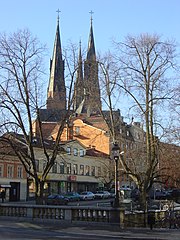Uppsala
From Wikipedia, the free encyclopedia.
- If you're searching for the Uppsala of Norse mythology, see Gamla Uppsala.
Uppsala [ˈɵpˌsɑ:la] (older spelling Upsala) 59°51′ N 17°38′ E is a Swedish City in central Sweden, located about 70 km north of Stockholm. It is the fourth largest city in Sweden with its 130,000 inhabitants; including immediate surroundings, Uppsala Municipality amounts to 180,000.
Uppsala is the capital of Uppsala County (Uppsala län), and Sweden's ecclesiastical centre, being the seat of Sweden's archbishop since 1164.
Contents |
History
Uppsala was originally located a few kilometers to the north, at a location now known as Gamla Uppsala (Old Uppsala). Today's Uppsala was then called Östra Aros. (Old) Uppsala was, according to medieval writer Adam of Bremen, the main heathen centre of Sweden, and the Temple at Uppsala contained magnificent idols of the Æsir gods.
After Christianization in the 11th century, the city withstood the Christian forces for an additional 50 years, but eventually the temple was demolished in the 11th century. As a replacement for the heathen gods, Uppsala was made into a strong Christian centre: a bishop was soon consecrated, and in 1164 Uppsala was made into an archdiocese, with the first Archbishop of Uppsala and Sweden was a monk from Alvastra being consecrated Archbishop Stefan.
The present-day Uppsala was at that time known as Östra Aros and was a port town of Gamla Uppsala. In 1274, Östra Aros overtook Gamla Uppsala as the main regional center, and when the cathedral of Gamla Uppsala burnt down, the archbishopric was moved to Östra Aros, and the impressive Uppsala cathedral erected.
Uppsala is the site of the oldest university in Scandinavia, founded in 1477. Carolus Linnaeus, one of the renowned scholars of the university, lived in the city for many years, and both his house and garden can still be visited. Uppsala Cathedral is built in the Gothic style and is one of the largest in northern Europe, with towers reaching 118 metres. Uppsala is also the site of a 16th century castle of royal roots.
The city was severely damaged by a fire in 1702. Historical and cultural treasures were also lost, as in many Swedish cities, from demolitions during the 1960s and 1970s. Despite the lack of understanding of the value of the older buildings at that time, many historic buildings remain, especially in the western part of the city.
The arms with the lion can be traced from 1737. It has been modernized several times since, most recently in 1986. The meaning of the lion is not certain but is likely connected to the royal lion, also depicted on the Coat of Arms of Sweden.
Politics
Historically, Uppsala has been a centre both of conservatism and liberalism, both receiving their ideological nourishment from the University. Today, the city is evenly divided between left and right and has since 1994 been governed by a coalition of the Social Democrats, the Left Party and the Green Party.
Geography
Situated on the fertile Uppsalaslätten flatlands of muddy soil, the city is dominated by the river Fyrisån flowing through the landscape surrounded by lush vegetation. Parallel to the river runs the glacial ridge of Uppsalaåsen, at an elevation of circa 30 metres the site of Uppsala's castle from which large parts of the town can be seen. The central park Stadsskogen streches from the south far into town, with opportunities for recreation for many residential areas within walking distance.
Only some 70 kilometers or 40 minutes by train from the capital, many Uppsala residents tend to work in Stockholm. The train to Stockholm-Arlanda Airport takes only 17 minutes, rending the city easily accessible by air.
The commercial centre of Uppsala can best be described as quite compact: While many beautiful buildings remain in the periphery of the central core, especially on the less intensively built western river bank around the cathedral, castle and university, retail commercial activity is geographically focused, if not restricted, to a minor number of blocks around the pedestrianized streets and main square, an area which was subject to large-scale post-World War II metamorphosis during the economically booming years in the 1960s in particular. During recent decades, a significant part of the retail commercial activity has been relocated to shopping malls and stores situated in the outskirts of the city. Alongside with this, the built up areas have expanded in a quite extensive way, and a certain suburbanization has taken place.

Economy
Today Uppsala is well established in medical research and recognized for its leading position in biotechnology.
- Pfizer (see Pharmacia)
- Fresenius
- Slotts (food manufacturer, including mustard)
- Lindvalls kaffe (coffee manufacturer)
Universities
- Uppsala University
- Swedish University of Agricultural Sciences (SLU, Sveriges Lantbruksuniversitet, main campus)
Sites of interest
Notable natives
- Olaus Rudbeckius
- Carolus Linnaeus
- Anders Celsius
- Jöns Jakob Berzelius
- Anders Jonas Ångström
- Dag Hammarskjöld
- Ingmar Bergman
- Arvid Carlsson
- Hans Blix
Of these, Celsius, Bergman, Carlsson and Blix were born in Uppsala
See also
- Uppsala Municipality (Kommun)
- Gamla Uppsala Old Uppsala in Norse mythology
- Temple at Uppsala The Temple of Old Uppsala in Norse Mythology
- Upsala Nya Tidning Uppsala newspaper
External links
- Uppsala - Official site
- Upsala Nya Tidning - Newspaper
- The Uppsala English Bookshop





